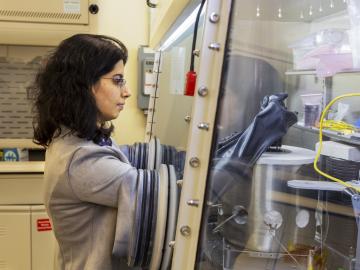
Filter News
Area of Research
- Advanced Manufacturing (2)
- Biology and Environment (31)
- Biology and Soft Matter (1)
- Clean Energy (46)
- Fusion and Fission (3)
- Fusion Energy (1)
- Isotopes (3)
- Materials (62)
- Materials Characterization (2)
- Materials for Computing (5)
- Materials Under Extremes (1)
- National Security (5)
- Neutron Science (14)
- Nuclear Science and Technology (1)
- Supercomputing (47)
News Type
News Topics
- (-) Decarbonization (64)
- (-) Exascale Computing (35)
- (-) Frontier (39)
- (-) Materials (100)
- 3-D Printing/Advanced Manufacturing (84)
- Advanced Reactors (18)
- Artificial Intelligence (78)
- Big Data (33)
- Bioenergy (74)
- Biology (81)
- Biomedical (46)
- Biotechnology (18)
- Buildings (31)
- Chemical Sciences (53)
- Clean Water (16)
- Climate Change (72)
- Composites (17)
- Computer Science (143)
- Coronavirus (34)
- Critical Materials (14)
- Cybersecurity (31)
- Education (4)
- Element Discovery (1)
- Emergency (2)
- Energy Storage (70)
- Environment (139)
- Fossil Energy (5)
- Fusion (44)
- Grid (40)
- High-Performance Computing (72)
- Hydropower (5)
- Isotopes (45)
- ITER (4)
- Machine Learning (35)
- Materials Science (94)
- Mathematics (7)
- Mercury (9)
- Microelectronics (3)
- Microscopy (36)
- Molten Salt (3)
- Nanotechnology (42)
- National Security (57)
- Net Zero (11)
- Neutron Science (96)
- Nuclear Energy (81)
- Partnerships (45)
- Physics (53)
- Polymers (20)
- Quantum Computing (30)
- Quantum Science (56)
- Renewable Energy (2)
- Security (22)
- Simulation (40)
- Software (1)
- Space Exploration (15)
- Statistics (2)
- Summit (51)
- Sustainable Energy (77)
- Transformational Challenge Reactor (7)
- Transportation (52)
Media Contacts

Researchers at the Department of Energy’s Oak Ridge, Brookhaven and Idaho national laboratories and Stony Brook University have developed a novel approach to gain fundamental insights into molten salts, a heat transfer medium important to advanced

Energy Secretary Jennifer Granholm visited ORNL on Nov. 22 for a two-hour tour, meeting top scientists and engineers as they highlighted projects and world-leading capabilities that address some of the country’s most complex research and technical challenges.

Ten scientists from the Department of Energy’s Oak Ridge National Laboratory are among the world’s most highly cited researchers, according to a bibliometric analysis conducted by the scientific publication analytics firm Clarivate.

The U.S. Department of Energy’s Office of Science announced allocations of supercomputer access to 51 high-impact computational science projects for 2022 through its Innovative and Novel Computational Impact on Theory and Experiment, or INCITE, program.

Amy Elliott, a group leader for robotics and intelligent systems at Oak Ridge National Laboratory, has received the 2021 ASTM International Additive Manufacturing Young Professional Award for her early career research contributions

Research teams from the Department of Energy’s Oak Ridge National Laboratory and their technologies have received seven 2021 R&D 100 Awards, plus special recognition for a COVID-19-related project.

A team led by the ORNL has found a rare quantum material in which electrons move in coordinated ways, essentially “dancing.”

A multidisciplinary team of scientists at ORNL has applied a laser-interference structuring, or LIS, technique that makes significant strides toward eliminating the need for hazardous chemicals in corrosion protection for vehicles.

Nearly a billion acres of land in the United States is dedicated to agriculture, producing more than a trillion dollars of food products to feed the country and the world. Those same agricultural processes, however, also produced an estimated 700 million metric tons of carbon dioxide equivalent in 2018, according to the U.S. Department of Agriculture.

As the United States transitions to clean energy, the country has an ambitious goal: cut carbon dioxide emissions in half by the year 2030, if not before. One of the solutions to help meet this challenge is found at ORNL as part of the Better Plants Program.


